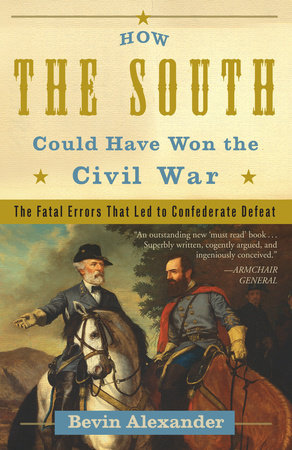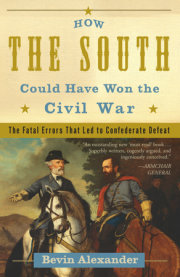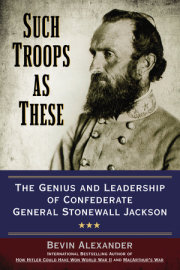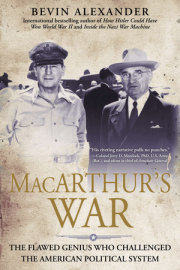Chapter 1
“There Stands Jackson Like a Stone Wall”
Only three months after Confederate troops red on Fort Sumter in Charleston harbor on April 12, 1861, Confederate leaders had to confront an invading Union army under General Irvin McDowell. This army was seeking a decision in the war by challenging a Southern army under Pierre Beauregard of Louisiana, the officer who had red on Sumter. Beauregard’s troops were lined up along the banks of Bull Run, a bold stream some twenty-five miles south of Washington in northern Virginia, near the little town of Manassas.1
There had scarcely been time for the South to organize military units, let alone come up with a strategic plan for achieving independence. The North did have a plan, however, and McDowell’s march on Bull Run was a part of it. The other parts, devised by Winfield Scott, the septuagenarian commander of the U.S. Army, called for throwing a sea blockade around the South and sending an army down the Mississippi River.2
McDowell’s movement was to be the first stage of a drive to Richmond, the Confederate capital. But lots of people in Washington thought the Southern army would be swept away by the larger and better-equipped Union forces at Bull Run, and that would be the end of it. The chastened Southern states would come back meekly into the Union and the country could go on about its business.
There was solid reasoning behind this view. The South had few weapons and fewer machine shops to build them, and the army Beauregard commanded had been built from scratch and seemed likely to disintegrate at the first tap. The North, however, had been able to pour unlimited money and materials into the new army that Abraham Lincoln had called to put down the “rebellion.”
But things in the South were not quite as seen from Washington. Lincoln’s decision to invade unified the Southern people and gave them tremendous resolve to resist. Volunteers ocked to the colors all over the South, and the Confederacy’s leaders, generally with more training in military affairs than the Northern chiefs, set out to create an army. They searched for every qualified man and tried to give him an assignment commensurate with his skills and promise, and the South’s needs.
Typical of the rapid response was the action of Virginia. Shortly after the state seceded on April 17, 1861, Governor John Letcher telegraphed the superintendent of the Virginia Military Institute at Lexington and ordered the corps of cadets to report to Richmond immediately to teach the ood of recruits gathering there how to march and wheel in formation—a skill the cadets knew to perfection. The superintendent chose Major Thomas J. Jackson to command the movement of the 176 young men. A West Point graduate, thirty-seven years old, thin, moderately tall, taciturn, deeply committed to his Presbyterian faith, and a hero of the Mexican War of 1846–48, Jackson had left the army in 1851 to become a professor of artillery tactics and mechanics at VMI. By April 26, Governor Letcher had commissioned Jackson as a colonel and sent him on from Richmond to command at Harpers Ferry on Virginia’s frontier, at the northern exit of the Shenandoah Valley.
On April 18, shortly before Jackson and the VMI cadets set off for Richmond, Robert E. Lee, a highly regarded colonel in the U.S. Army, was in Washington, having been summoned there by his old boss, General Scott, on whose staff Lee had served with distinction during the 1847 march on Mexico City in the Mexican War. Lee, scion of a famous Virginia family, was fifty-four years old, fairly tall, extremely handsome, unfailingly courteous to everyone high and low, and an honors graduate of West Point, where he had been superintendent from 1852 to 1855. Francis P. Blair Sr., a publisher and close associate of President Lincoln, met with Lee and informed him that Lincoln had offered him command of the U.S. Army. Lee declined, saying he could take no part in the invasion of the South. Though deeply distressed at the division of the country, Lee felt he had to offer his sword to his native state. On April 20, he resigned his commission, left his estate at Arlington, just across the Potomac from the capital (present-day site of Arlington National Cemetery), took the train to Richmond, and accepted Governor Letcher’s appointment as major general and commander of Virginia forces.
His job did not last long. On May 2 Virginia ratified the Confederate Constitution and joined the new nation. When President Jefferson Davis moved the Confederate capital from Montgomery, Alabama, to Richmond on May 29, Lee became an unofficial military adviser to the Confederate president (who, like the Union president, was the constitutional commander in chief). Lee recommended to Davis that Beauregard be assigned to command the troops at Manassas, but he had no role in the upcoming battle.
Meanwhile, the Confederate War Department assigned one of its highest-ranking officers, Brigadier General Joseph E. Johnston, a Virginia native, to command at Harpers Ferry, superseding Thomas Jackson, who was assigned to lead the 2,600 men of the new 1st Virginia Brigade. Johnston felt Harpers Ferry was indefensible, and moved his little army twenty-five miles southwest to Winchester.
• • •
The military situation in July 1861 was as follows: Irvin McDowell had a Federal army of 37,000 men at Alexandria and vicinity facing P. G. T. Beauregard’s 22,000 men at Manassas, while another Union army of 15,000 men under Robert Patterson had moved south of Harpers Ferry to challenge Joseph Johnston’s 11,000 men at Winchester. Washington leaders feared that Johnston might burst out of the Shenandoah Valley and attack the capital while McDowell was dealing with Beauregard at Bull Run.
On July 16, McDowell started on a thirty-mile march from Alexandria west to Bull Run. He took 32,000 men, leaving 5,000 in defensive works guarding Washington. Word of the march leaked out the next day. Patterson’s clear duty was to keep Johnston bottled up in the Shenandoah Valley. Winfield Scott had assured McDowell that Patterson would do just that. Unfortunately Patterson’s duty was not clear to Patterson himself, who was sixty-nine years old and had no experience in independent command. Johnston made some threatening moves against Patterson’s Union army at Bunker Hill, ten miles north of Winchester.
Thoroughly intimidated and believing Johnston might cut him off from his supplies, Patterson hurried his army northeastward to Charles Town on the very day that McDowell commenced his march to Bull Run. This put him twenty miles from Winchester and released Johnston from the vise.
The first principle of war is to concentrate superior force at the decisive point. In July 1861 this point was along the banks of Bull Run. McDowell and Patterson together commanded more than 50,000 men. The South, even if Johnston and Beauregard could get together, had only 33,000. In the days of single-shot infantry weapons, numbers counted for very much, because adding numbers was the only way firepower could be increased.
General Scott knew his forces should be concentrated. He also knew it would be impossible for Johnston’s Confederate forces to march twenty-five miles to Harpers Ferry, cross the Potomac River, then drive the fifty-five miles to Washington before a decision could be reached at Bull Run. He explained to President Lincoln that if Johnston attempted this, he would be operating on “exterior lines,” or on a roundabout approach, whereas Patterson, in marching to reinforce McDowell, would be moving directly, thus operating on “interior lines.” But this was too arcane a concept for Lincoln. He reected rather the panic he felt all around him, and insisted that Patterson be kept in the Shenandoah Valley to hold Johnston at bay.
Events were to show that Beauregard and Johnston were in the second tier of Confederate commanders in terms of ability. But they saw that Lincoln’s anxiety had dispersed Union forces, giving them the opportunity to make up in activity for their lack of strength. They rushed to combine their forces against only a part of the enemy and defeat this part before having to deal with the other part.
At 1:00 a.m. on Thursday, July 18, 1861, a wire from the War Department in Richmond alerted Johnston that McDowell was on the march. Move quickly, the wire ordered, to Manassas if practicable. Johnston set his army in motion the fifty-seven miles to Manassas.
Johnston sent his amboyant cavalry chief, J. E. B. (“Jeb”) Stuart, off at a gallop with his 1st Virginia Cavalry Regiment toward Charles Town to create confusion and seal off Patterson’s avenues of reconnaissance. For that entire day and for most of the next, Patterson was unaware that Johnston’s army had disappeared. When he did learn, it was too late. One adept, fast move by Johnston had wiped Patterson’s whole army from the order of battle. In the collision to come, Patterson’s forces might as well have been on another planet.
Thomas Jackson’s 1st Virginia Brigade led the march from Winchester across Ashby’s Gap in the Blue Ridge Mountains (through which U.S. Routes 17 and 50 now run). At the little village of Paris, on the eastern slopes of the Blue Ridge, twenty miles from Winchester, Jackson’s exhausted troops collapsed for the night. An officer reminded Jackson that not enough pickets had been posted. Jackson replied, “Let the poor fellows sleep. I will guard the camp myself.” And Jackson, through the summer night, stood sentry over his sleeping men.
Next morning, the brigade marched six miles down to Piedmont Station (now Delaplane) on the Manassas Gap Railroad and entrained for Manassas Junction, thirty-four miles away. This was just the second time in history that troops had been moved by rail to battle. Only in 1859 in a brief conict between France and Austria in Italy had it been done. Armies on both sides would increasingly rely on railroads not only to move troops quickly and in large numbers—something never possible before—but also to supply these armies at distant points. The old order of relying on magazines, or supply depots, maintained only a short distance from troops, passed away. The umbilical cord of armies now became the rail line. If it was intact, armies could survive wherever they were located. If it was severed, armies had to repair the cut, move, or die.
But none of this was in the minds of the young soldiers of Jackson’s brigade as they rode across the rolling Virginia countryside on July 19, 1861. The trip took eight hours, and it was a lark. At every stop enthusiastic crowds swarmed around the cars, girls in their finery waved and irted, housewives showered them with food, and everybody sang patriotic songs such as “Dixie” and “The Bonnie Blue Flag.”
Jackson announced his brigade’s arrival to Beauregard at his headquarters at the Wilmer McLean farmhouse, on a shady knoll half a mile below Bull Run.3 He told Beauregard that Johnston’s remaining three brigades were coming by rail behind him.4
But these troops were in the process of becoming the victims of military history’s first railway traffic jam. The three brigades reached Piedmont Station during the afternoon of July 19, but the railroad had no extra employees to bring in. Train crews were able to get only Francis S. Bartow’s brigade of 1,400 men to Manassas by dawn on July 20, while Johnston himself arrived with 1,000 men from Barnard E. Bee’s brigade during the day on July 20. On the day of the battle, Sunday, June 21, 2,000 men from E. Kirby Smith’s brigade reached the Manassas station at noon and marched directly into the fight. The last 2,500 infantry of Johnston’s army did not arrive until after the battle was over.
Beauregard conceived plans that were far too airy to be carried out. On July 19, he asked Johnston to throw his army on McDowell’s right ank at Centreville, on the Warrenton Turnpike (now U.S. Route 29) some three miles above Bull Run, while Beauregard attacked northward from the stream. Combining two parts of an army on the field of battle is an extremely difficult task even for experienced forces, which the Confederate troops were not. To be successful, this approach requires awless execution, no unanticipated barriers, and a cooperative enemy. Johnston sensibly rejected Beauregard’s idea and insisted on combining the two forces behind Bull Run.
Beauregard had organized his army poorly and had placed it in a dangerously exposed position. While McDowell had formed his army into five divisions, a structure whose effectiveness had been proved in the Napoleonic wars more than half a century before, Beauregard had rejected divisions and left his smaller force divided into six independent brigades, with a number of separate regiments and artillery batteries. This made the command structure far too complex for him and his untrained staff to handle efficiently.
Beauregard had set up a line of battle stretching nearly seven miles along the somewhat crooked course of Bull Run, much too extensive for the troops he possessed. He had concentrated the bulk of his forces—five brigades, or about 16,000 troops—in the three miles between Union Mills Ford on the right, or east, and Mitchell’s Ford to the west. Two other fords, Blackburn’s and McLean’s, were located along this stretch of the stream. Beauregard had another 5,000 men: Philip St. George Cocke’s brigade and Nathan G. (Shanks) Evans’s small detachment (the 4th South Carolina Regiment and the 1st Louisiana “Tigers” battalion). But he positioned these troops too far to the west to be available for any coordinated action; Cocke stood at Ball’s Ford, a couple of miles west of Mitchell’s Ford, while Shanks guarded the Stone Bridge over Bull Run on the Warrenton Pike.
In the terminology of the time, both of Beauregard’s anks were oating “in the air,” meaning they rested on no solid defensive position such as a stream or a mountain. They were set up to defend Bull Run to the north, not to hold against an enemy movement from either the west or the east.
When Jackson’s brigade arrived on July 19, Beauregard placed it in reserve behind Mitchell’s Ford.5 On July 20, when the brigades of Bartow and Bee arrived (along with Johnston himself), Beauregard stationed them in reserve behind Blackburn’s Ford.
Thus on the eve of battle, the only reserve forces with any hope of quick movement to the left or west—the most obvious point of danger—were Jackson’s, Bee’s, and Bartow’s brigades. And they were still four to five miles away from Evans at the Stone Bridge.
Beauregard’s plan of battle was based on his conviction that McDowell would attack at Blackburn’s Ford. He expected James Longstreet’s brigade, positioned at this ford, to stop the attack, and two brigades to the west—Milledge L. Bonham’s at Mitchell’s Ford and Cocke’s at Ball’s Ford—to hold. At the same time, he expected three other brigades—Richard S. Ewell’s, D. R. Jones’s, and Jubal A. Early’s—to cross Bull Run, execute a wide movement around the Union army, and seize Centreville, three miles north of the stream, and Fairfax Court House, eight miles east of Centreville. As soon as this turning movement was under way, Bonham and Longstreet were to join in.
Copyright © 2008 by Bevin Alexander. All rights reserved. No part of this excerpt may be reproduced or reprinted without permission in writing from the publisher.












